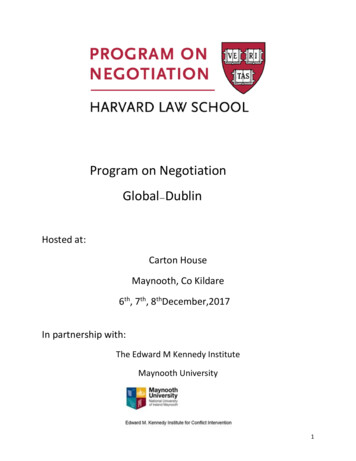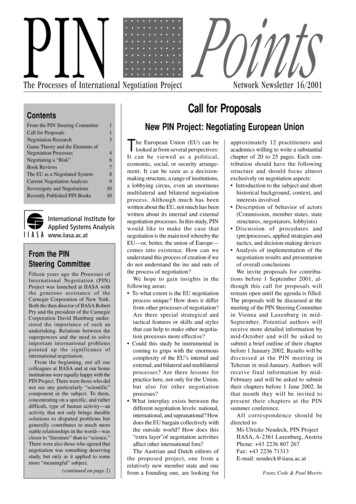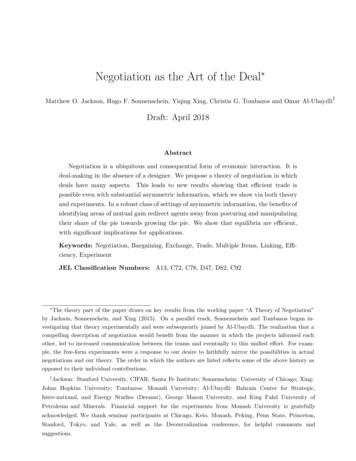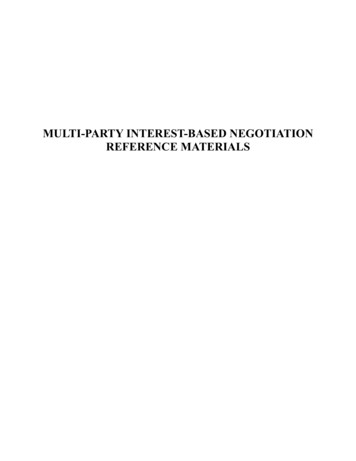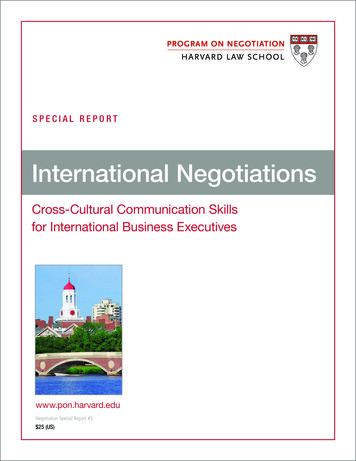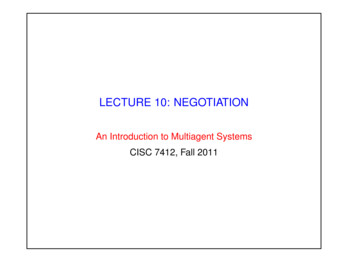
Transcription
LECTURE 10: NEGOTIATIONAn Introduction to Multiagent SystemsCISC 7412, Fall 2011
Lecture 10An Introduction to Multiagent SystemsReaching agreement How do agents reach agreements when they are self interested? In an extreme case (zero sum encounter) no agreement ispossible — but in most scenarios, there is potential for mutuallybeneficial agreement on matters of common interest. The capabilities of:– negotiation and– argumentationare central to the ability of an agent to reach such agreements. This lecture will talk about negotiation and next week we’ll go onto cover argumentation.c M. J. Wooldridge, used by permission/Updated by Simon Parsons, Fall 20111
Lecture 10An Introduction to Multiagent SystemsTwo pictures that summarise negotiationc M. J. Wooldridge, used by permission/Updated by Simon Parsons, Fall 20112
Lecture 10An Introduction to Multiagent SystemsMechanisms, Protocols, and Strategies Negotiation is governed by a particular mechanism, or protocol. The mechanism defines the “rules of encounter” between agents. Mechanism design is designing mechanisms so that they havecertain desirable properties.– Properties like Pareto efficiency Given a particular protocol, how can a particular strategy bedesigned that individual agents can use?c M. J. Wooldridge, used by permission/Updated by Simon Parsons, Fall 20113
Lecture 10An Introduction to Multiagent Systems Auctions are only concerned with the allocation of goods: richertechniques for reaching agreements are required. Negotiation is the process of reaching agreements on matters ofcommon interest. Any negotiation setting will have four components:– A negotiation set: possible proposals that agents can make.– A protocol.– Strategies, one for each agent, which are private.– A rule that determines when a deal has been struck and whatthe agreement deal is. Negotiation usually proceeds in a series of rounds, with everyagent making a proposal at every round.c M. J. Wooldridge, used by permission/Updated by Simon Parsons, Fall 20114
Lecture 10An Introduction to Multiagent Systems There are a number of aspects of negotiation that make itcomplex. Multiple issues– Number of possible deals is exponential in the number ofissues.(Like the number of bundles in a combinatorial auction)– Hard to compare offers across multiple issuesThe car salesman problem Multiple agents– One-to-one negotiation– Many-to-one negotiation– Many-to-many negotiation At the simple end there isn’t much to distinguish negotiation fromauctions.c M. J. Wooldridge, used by permission/Updated by Simon Parsons, Fall 20115
Lecture 10An Introduction to Multiagent SystemsNegotiation for Resource Division We will start by looking at Rubinstein’s alternating offers model. This is a one-to-one protocol. Agents are 1 and 2, and they negotiate over a series of rounds:0, 1, 2, . . . In round 0, Agent 1 makes an offer x0. Agent 2 either accepts A, or rejects R. If the offer is accepted, then the deal is implemented. If not, we have round 1, and Agent 2 makes an offer.c M. J. Wooldridge, used by permission/Updated by Simon Parsons, Fall 20116
Lecture 10An Introduction to Multiagent SystemsstartAgent 1 makes a proposalAgent 2acceptsAgent 2 rejectsAgent 1rejectsAgent 2 makes a proposalc M. J. Wooldridge, used by permission/Updated by Simon Parsons, Fall 20117
Lecture 10An Introduction to Multiagent Systems The rules of the protocol don’t mean that agreement will ever bereached.– Agents could just keep rejecting offers. If there is no agreement, we say the result is the conflict deal Θ. We make the following basic assumptions:– Disagreement is the worst ouctomeBoth agents prefer any agreement to none.– Agents seek to maximise utilityAgents prefer to get larger utility values With this basic model, we get some odd results.c M. J. Wooldridge, used by permission/Updated by Simon Parsons, Fall 20118
Lecture 10An Introduction to Multiagent Systems Consider you and I are dividing a pie (m’mmmm, pie)c M. J. Wooldridge, used by permission/Updated by Simon Parsons, Fall 20119
Lecture 10An Introduction to Multiagent Systems Model this as some resource with value 1, that is divided into twoparts.– Each part is between 0 and 1.– The two parts sum to 1so a proposal is (x, 1 x) The set of possible deals is:{(x, 1 x) : 0 x 1} If you are Agent 1, what do you offer?c M. J. Wooldridge, used by permission/Updated by Simon Parsons, Fall 201110
Lecture 10An Introduction to Multiagent Systems Let’s assume that we will only have one round.(A version of the Ultimatum game). Agent 1 has all the power. If Agent 1 proposes (1, 0), then this is still better for Agent 2 thanthe conflict deal. Agent 1 can do no better than this either. So we have a Nash equilibrium.c M. J. Wooldridge, used by permission/Updated by Simon Parsons, Fall 201111
Lecture 10An Introduction to Multiagent Systems If we have two rounds, the power passes to Agent 2. Whatever Agent 1 proposes, Agent 2 rejects it. Then Agent 2 proposes (0, 1). Just as before this is still better for Agent 1 than the conflict dealand so it is accepted. A bit of thought shows that this will happen any time there is afixed number of rounds.c M. J. Wooldridge, used by permission/Updated by Simon Parsons, Fall 201112
Lecture 10An Introduction to Multiagent Systems What if we have an indefinite number of rounds. Let’s say that Agent 1 uses this strategy:Always propose (1, 0) and always reject any offer fromAgent 2 How should Agent 2 respond?c M. J. Wooldridge, used by permission/Updated by Simon Parsons, Fall 201113
Lecture 10An Introduction to Multiagent Systems If Agent 2 rejects, then there will never be agreement.– We end up with the conflict deal So Agent 2 should accept. And there is no point in not accepting on the first round. In fact, whatever (x, 1 x) agent 1 proposes here, immediateacceptance is the Nash equilibrium so long as Agent 2 knowswhat Agent 1’s strategy is.– There are thus an infinite number of Nash Equilibria.– All are Pareto optimal.c M. J. Wooldridge, used by permission/Updated by Simon Parsons, Fall 201114
Lecture 10An Introduction to Multiagent SystemsAside: T. Rex on the Ultimatum gamec M. J. Wooldridge, used by permission/Updated by Simon Parsons, Fall 201115
Lecture 10An Introduction to Multiagent SystemsImpatient players Since we have an infinite number of Nash equilibria, the solutionconcept of NE is too weak to help us. Can get unique results if we take time into account.For any outcome x and times t2 t1, both agents prefer x attime t1. A standard way to model this impatience is to discount the valueof the outcome.c M. J. Wooldridge, used by permission/Updated by Simon Parsons, Fall 201116
Lecture 10An Introduction to Multiagent Systems Each agent has δi, i {1, 2}, where 0 δ 1. The closer δi is to 1, the more patient the agent is. If agent i is offered x, then the value of the slice is:– x at time 0– δix at time 1– δi2x at time 2.– δ k x at time k Now we can make some progress with the fixed number ofrounds.c M. J. Wooldridge, used by permission/Updated by Simon Parsons, Fall 201117
Lecture 10An Introduction to Multiagent Systems A 1 round game is still an ultimatum game. A 2 round game means Agent 2 can play as before, but if so, willonly get δ2.Gets the whole pie, but it is worth less. Agent 1 can take this into account. If Agent 1 offers:(1 δ2, δ2)then Agent 2 might as well accept — can do no better. So this is now a Nash equilibrium.c M. J. Wooldridge, used by permission/Updated by Simon Parsons, Fall 201118
Lecture 10An Introduction to Multiagent Systems In the general case, agent 1 makes the proposal that gives Agent2 what Agent 2 would be able to enforce in the second round. Agent 1 gets:1 δ21 δ1δ2 Agent 2 gets:δ2(1 δ1)1 δ1δ2 Note that the more patient either agent is, the more pie they get.c M. J. Wooldridge, used by permission/Updated by Simon Parsons, Fall 201119
Lecture 10An Introduction to Multiagent SystemsHeuristic approach The approach we just talked about relies on strategic thinkingabout the other player. A simpler approach is to use some heuristic approximation ofhow the value of the pie varies for the players. Some common approximations:– Boulware– Conceder We can see what these look like for sellers.c M. J. Wooldridge, used by permission/Updated by Simon Parsons, Fall 201120
Lecture 10An Introduction to Multiagent 0.40.60.81.0c M. J. Wooldridge, used by permission/Updated by Simon Parsons, Fall 201121
Lecture 10An Introduction to Multiagent Systems Boulware– Very slow increase until close to deadline and then anexponential increase. Conceder– Inital exponential increase to close to the reserve price andthen not much change.c M. J. Wooldridge, used by permission/Updated by Simon Parsons, Fall 201122
Lecture 10An Introduction to Multiagent SystemsNegotiation in Task-Oriented DomainsImagine that you have three children, each of whom needs to be delivered to a different schooleach morning. Your neighbour has four children, and also needs to take them to school. Deliveryof each child can be modelled as an indivisible task. You and your neighbour can discuss thesituation, and come to an agreement that it is better for both of you (for example, by carrying theother’s child to a shared destination, saving him the trip). There is no concern about being ableto achieve your task by yourself. The worst that can happen is that you and your neighbour won’tcome to an agreement about setting up a car pool, in which case you are no worse off than ifyou were alone. You can only benefit (or do no worse) from your neighbour’s tasks. Assume,though, that one of my children and one of my neigbours’s children both go to the same school(that is, the cost of carrying out these two deliveries, or two tasks, is the same as the cost ofcarrying out one of them). It obviously makes sense for both children to be taken together, andonly my neighbour or I will need to make the trip to carry out both tasks.c M. J. Wooldridge, used by permission/Updated by Simon Parsons, Fall 201123
Lecture 10An Introduction to Multiagent SystemsTODs Defined A task-oriented domain (TOD) is a triplehT, Ag, ciwhere:– T is the (finite) set of all possible tasks;– Ag {1, . . . , n} is set of participant agents;– c : (T) IR defines cost of executing each subset of tasks: An encounter is a collection of taskshT1, . . . , Tniwhere Ti T for each i Ag.c M. J. Wooldridge, used by permission/Updated by Simon Parsons, Fall 201124
Lecture 10An Introduction to Multiagent SystemsDeals in TODs Given encounter hT1, T2i, a deal will be an allocation of the tasksT1 T2 to the agents 1 and 2. The cost to i of deal δ hD1, D2i is c(Di), and will be denotedcosti(δ). The utility of deal δ to agent i is:utilityi(δ) c(Ti) costi(δ). The conflict deal, Θ, is the deal hT1, T2i consisting of the tasksoriginally allocated.Note thatutilityi(Θ) 0 for all i Ag Deal δ is individual rational if it gives positive utility.c M. J. Wooldridge, used by permission/Updated by Simon Parsons, Fall 201125
Lecture 10An Introduction to Multiagent SystemsThe Negotiation Set The set of deals over which agents negotiate are those that are:– individual rational– Pareto efficient. Individually rational: agents won’t be interested in deals that givenegative utility since they will prefer the conflict deal. Pareto efficient: agents can always transform a non-Paretoefficient deal into a Pareto efficient deal by making one agenthappier and none of the others worse off.c M. J. Wooldridge, used by permission/Updated by Simon Parsons, Fall 201126
Lecture 10An Introduction to Multiagent SystemsThe Negotiation Set Illustratedutility foragent ideals on this linefrom B to C arePareto optimal,hence in thenegotiation setButility of conflictdeal for iAEconflict dealthis circle delimits thespace of allpossible dealsCDutility foragent jutility of conflictdeal for jc M. J. Wooldridge, used by permission/Updated by Simon Parsons, Fall 201127
Lecture 10An Introduction to Multiagent SystemsThe Monotonic Concession ProtocolRules of this protocol are as follows. . . Negotiation proceeds in rounds. On round 1, agents simultaneously propose a deal from thenegotiation set. Agreement is reached if one agent finds that the deal proposedby the other is at least as good or better than its proposal. If no agreement is reached, then negotiation proceeds to anotherround of simultaneous proposals. In round u 1, no agent is allowed to make a proposal that is lesspreferred by the other agent than the deal it proposed at time u. If neither agent makes a concession in some round u 0, thennegotiation terminates, with the conflict deal.c M. J. Wooldridge, used by permission/Updated by Simon Parsons, Fall 201128
Lecture 10An Introduction to Multiagent SystemsThe Zeuthen StrategyThree problems: What should an agent’s first proposal be?Its most preferred deal On any given round, who should concede?The agent least willing to risk conflict. If an agent concedes, then how much should it concede?Just enough to change the balance of risk.c M. J. Wooldridge, used by permission/Updated by Simon Parsons, Fall 201129
Lecture 10An Introduction to Multiagent SystemsWillingness to Risk Conflict Suppose you have conceded a lot. Then:– Your proposal is now near to conflict deal.– In case conflict occurs, you are not much worse off.– You are more willing to risk confict. An agent will be more willing to risk conflict if the difference inutility between its current proposal and the conflict deal is low.c M. J. Wooldridge, used by permission/Updated by Simon Parsons, Fall 201130
Lecture 10An Introduction to Multiagent SystemsNash Equilibrium Again. . .The Zeuthen strategy is in Nash equilibrium: under the assumptionthat one agent is using the strategy the other can do no better thanuse it himself. . .This is of particular interest to the designer of automatedagents. It does away with any need for secrecy on the part ofthe programmer. An agent’s strategy can be publicly known,and no other agent designer can exploit the information bychoosing a different strategy. In fact, it is desirable that thestrategy be known, to avoid inadvertent conflicts.c M. J. Wooldridge, used by permission/Updated by Simon Parsons, Fall 201131
Lecture 10An Introduction to Multiagent SystemsDeception in TODsDeception can benefit agents in two ways: Phantom and Decoy tasks.Pretending that you have been allocated tasks you have not. Hidden tasks.Pretending not to have been allocated tasks that you have been.c M. J. Wooldridge, used by permission/Updated by Simon Parsons, Fall 201132
Lecture 10An Introduction to Multiagent SystemsSummary This lecture started to look at different mechanisms for reachingagreement between agents. In particular we looked at negotiation, where agents makeconcessions and explore tradeoffs. We looked at negotiations about the division of resources.– Ultimatum game and its variants We also looked at negotiation in task-oriented domains whereagents can find synergies between tasks and exploit these toreach agreement. Next week we will go on to talk about argumentation, anotherfamily of techniques for reaching agreement.c M. J. Wooldridge, used by permission/Updated by Simon Parsons, Fall 201133
Negotiation is the process of reaching agreements on matters of common interest. Any negotiation setting will have four components: - A negotiation set: possible proposals that agents can make. - A protocol. - Strategies, one for each agent, which are private. - A rule that determines when a deal has been struck and what the agreement .
